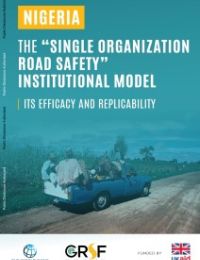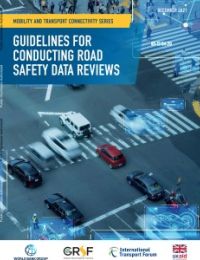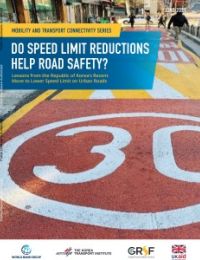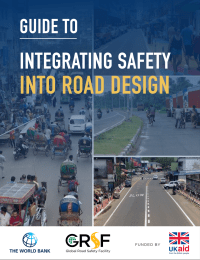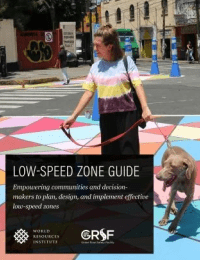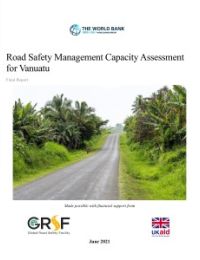Publications
21-30 of 44
-
Speed Management
Road Crash Trauma, Climate Change, Pollution and the Total Costs of Speed: Six Graphs That Tell the Story
July 2022
-
-
Road Safety Management
Nigeria: The “Single Organization Road Safety” Institutional Model, its Efficacy and Replicability
July 2022
-
What are the strengths and weaknesses of this model and what could be done to improve its’ efficiency and effectiveness?
-
How efficient and effective is the “Single Organizational Model” institutional setup (both federal and state levels) in dealing with the road safety issues in Nigeria?
-
Can this model be replicated in other LMICs and what are the factors that will determine the replicability of the model in those countries?
-
What are the steps in setting up “Single Organizational Model” institutions in LMICs?
-
-
Speed Management
Guide for Determining Readiness for Speed Cameras and Other Automated Enforcement
July 2022
-
To briefly identify the powerful practical value of AE in saving lives and reducing injuries.
-
To identify issues and criteria to be considered before commencing automated enforcement. To identify steps to be taken to achieve readiness for automated enforcement. To identify issues to improve existing automated enforcement systems.
-
To provide a checklist to ensure adequate consideration is given to issues to assess readiness to implement an AE system or improve an existing system.
- Evaluate the effectiveness of the reduced speed limits in terms of crash reduction through a before-after study.
- Examine if the speed limit change had different effects across different crash types, user types, and crash severities.
- Evaluate the impact of speed limit change on transit speed through a before-after assessment.
- Develop appropriate and actionable recommendations for departments of transportation in developing countries.
-
-
Road Infrastructure
Practical Guide for Road Safety Auditors and Inspectors in Ukraine (Ukrainian)
July 2022
-
-
Traffic crashes are a leading cause of death and serious injury worldwide; most notably, they are the leading cause of death and serious injury among young people aged 5–29. Higher motor vehicle speeds increase the likelihood and severity of crashes.
-
Low-speed zones have emerged as one of the most promising strategies for speed management. They can be appropriate in many different contexts and at various scales, as exemplified by case studies of successful projects around the world.
-
Low-speed zones in cities need to be well-planned, well-designed, and well-built, to maximize safety and other benefits.
-
Physical traffic-calming measures and target speeds of 30 kilometers/hour (km/h) or lower have the greatest proven safety benefits.
-
Key considerations for implementation include stakeholder engagement, site selection (including risk: pedestrian/vulnerable road user presence), enforcement, evaluation, and the adaptation of basic principles for low-speed zone design to the local context.
-

What is the real cost of speeding on people and the environment? These 6 graphs tell the story ⌵︎
The impacts of speed on the safety of road users, on congestion, on pollution, and on total costs of road travel are broadly misunderstood: often based on wrong assumptions, with effects taken as self-evident, failure to consider multiple impacts, externalization of costs by many stakeholders, and under-estimation of impacts (especially economic costs of higher speeds). The purpose of this brief note is to provide information on these relationships relevant to fundamental road transport policies, design, and operation. Well-established evidence shows the importance of managing travel speeds for road safety, for efficiency, for improved inclusion, and for greenhouse gas (GHG) and other emissions. Thus, speed management is a strong policy lever for the breadth of issues which must be addressed for sustainable mobility.
Reduced speeds of travel represent a major, yet under-appreciated, opportunity to improve safety, climate change impacts of travel, health, inclusion, the economy, and in some circumstances, congestion. Speed management can be achieved through a range of interventions including road infrastructure and vehicle technology, as well as enforcement and promotion.
The six graphs presented in this note tell a powerful story, across the range of these benefits of speed management.
This publication is also available in:
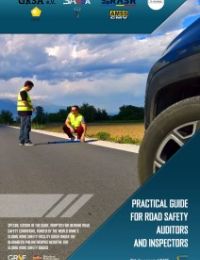
After almost two decades of experience with Road Safety Audit (RSA) Worldwide, this procedure is now recognized as one of the most efficient engineering tools. RSA is a highly efficient and cost-effective engineering tool for improvement of safety on roads. It is much cheaper to identify road safety deficiencies in the process of design than later after construction is completed. RSAs are among the most cost-effective investments a Road Authority can undertake.
With its EU Directive No. 2008/96 and amendment 2019/1936 on road infrastructure safety management, the European Union (EU) made a clear decision that RSA will be mandatory for the Trans-European Road Network (TERN) and main roads. This Directive contains another tool called Road Safety Inspection (RSI) on safety deficiencies of existing roads. The RSI is very similar to the process of Road Safety Audit in the pre-opening phase of newly constructed roads. RSIs are essential for the redesign and upgrading of existing roads, and these are done in many countries to give the designers insights and direction for safety improvements. Given that, the purpose of this practical guide is to provide practical guidance to those doing RSAs and RSIs, the examples of typical design deficiencies shown should be useful to both road safety inspectors and road safety auditors.
This document draws on the more comprehensive guidelines and manuals on Safety engineering mentioned in the acknowledgements but deliberately focuses only on these issues of direct relevance to road safety auditors/inspectors and to the road safety reports that they must prepare, including of recommendations for improvements.
This is a special edition of the guide, adapted for Ukraine road safety conditions and legislation, funded by the World Bank‘s Global Road Safety Facility (GRSF) under the Bloomberg Philanthropies Initiative for Global Road Safety (BIGRS).
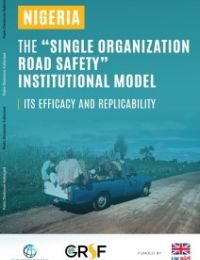
This study is one part of a comprehensive study of lead road safety agencies in low- and middle-income countries (LMICs), which is being conducted on a collaborative basis by the World Bank, the World Health Organization, and the African Development Bank. This particular study is supported by UK Aid through the World Bank’s Global Road Safety Facility (GRSF). It focuses on the case of Nigeria, a federal republic with three tiers of government - federal (central), state and local governments - and its single institutional model for road safety.
This report responds to the following questions:
Download the report to learn more!
RESOURCES ⌵︎
ACKNOWLEDGMENTS ⌵︎
‘The “Single Organization Road Safety” Institutional Model, its Efficacy and Replicability’ Study is supported by UK Aid through GRSF. The Report was written by three main authors: Martin Small, Mustapha Azzouzi and Arpita Roy. The study was led by Farhad Ahmed (Senior Transport Specialist) with support from Md. Towshikur Rahman, who was responsible for the overall coordination.
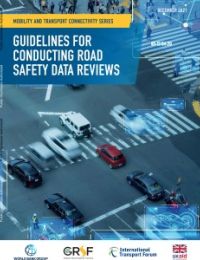
Download the document in English
Download the document in French
Download the document in Spanish
In many countries around the world, deficiencies in data or data quality impair evidence-based road safety policy making. While many countries collect road safety data, the collection is not necessarily comprehensive. Further, many countries can be unaware of data gaps in their system, which prevents them from soundly analyzing their road safety problems. Therefore, road safety data definitions and collection methods must converge into standard international criteria, thus allowing for comparisons in space - across countries - and in time.
This is the raison d’etre of regional road safety observatories, which have been developed, for example, in Latin America (OISEVI), Africa (ARSO), and Asia-Pacific (APRSO). They present an opportunity for joint regional efforts to improve, in a harmonized way, road safety data collection and analysis. Regional road safety observatories promote the adoption of a common set of road safety indicators based on common definitions and serve as an avenue to assist countries in improving the management of their crash data systems.
This document is designed to support reviewers in the assessment of road safety data collection; the complete range of safety data should be considered. This task can be complicated because collection of road safety data is often not achieved by activities dedicated to this purpose, but rather through piggybacks on other sources. For example, activity reports from police or hospitals are used to provide material for legal or medical purposes. The routines involved frequently have a long history in which gathering reliable and complete statistics has had secondary priority, at best. The various actors involved reflect the complex structure of a country’s judicial and executive system, which, generally, are not coordinated. Consequently, any review of the data collection process requires some “detective work.”

This guide has been prepared to assist a jurisdiction to determine the level of readiness to move to automated enforcement (AE). Speed cameras enforcing speed limits are a common application of AE and there are many systemic legal and operational elements that must be in place before AE can be effective. For example, an accurate image of a speeding vehicle, in the absence of robust driver licensing and vehicle registration systems, is of little road safety value. Importantly, automated speed enforcement should be considered as one part of a comprehensive speed management approach that includes road infrastructure and roadside policing as well. The management of speed is a fundamental element of the Safe System.
Aims of this document:
Other illegal behaviours, including disobeying a red light signal, mobile or cellular phone use, incorrect lane use, and non-restraint use can also be detected using an automated enforcement approach. However, this document applies specifically to automated speed enforcement, because speed management requires significant attention worldwide and plays a critical role in reducing road traffic deaths and injuries.
Document also available in French, Portuguese, Vietnamese and Spanish.
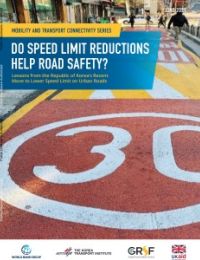
Significant research has been undertaken on how changes in speed limit—for example, the introduction of 30 kilometers per hour, or kph (20 miles per hour, or mph) speed limits—impact safety both when combined with, and without "traffic-calming" engineering treatments such as speed humps or raised platforms. However, most of the studies have been conducted in Australia or countries in Western Europe, with almost no recorded studies from Asia, Africa, the Americas, and Eastern Europe. Though it may be reasonable, a well-developed infrastructural environment such as that found in Korea would expect similar results as that of the western countries, a study originating in Asia could have a strong demonstration effect and prove very convincing for many Asian countries.
With this in mind, the main aim of this study is to present the findings from Korea’s reduced speed limits on safety performance and to support the establishment of suitable speed-management strategies based on a quantitative data-driven approach. The scope of the project was as follows:
To start, this report first provides a brief literature review on the concept of Safe System speed limits, and the effect of speed limit reductions as part of speed management in several countries, followed by a brief description of the evaluation methods for the before-after assessment. This is followed by a summary of the findings, a set of recommendations, limitations of this study, and finally, a capsule of future research that could be undertaken to either extend or follow up on the study.
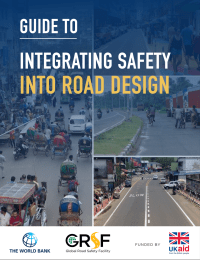
This guide focuses on elements of safe road and roadside designs for road networks that can provide safe mobility to all road users
A substantial reduction in road deaths will only be feasible if concerted efforts are made, following the “Safe System” approach involving all elements of road safety, management, and delivery. This includes all pillars of the Safe System—starting from road safety management, safe roads and roadsides, safe speed, safe vehicles, safe road users, and post-crash care. This guide focuses on elements of safe road and roadside designs for road networks that can provide safe mobility to all road users, as well as complementary changes to improve speeds, vehicle safety, road user behaviors, and post-crash care. A balanced road design must take into account these complementary system elements to maximize safety benefits. The energy carried by a moving object is proportional to the square of its speed. A well-designed “forgiving roadside” ensures that this energy is dispersed in a crash, and as a result, less energy is transferred to the occupants.
Road infrastructure design plays a vital role in road safety outcomes. Safe infrastructure supports other road safety pillars by encouraging appropriate road user behavior (such as appropriate speed and correct lane position) and by providing a forgiving road environment if things go wrong. Poorly designed road infrastructure can give rise to dangerous road user behavior. One of the key realizations of the Safe System approach is that drivers make mistakes and will continue to do so, even if we can reduce how often these occur. This road user error has long been recognized as a significant contributor to poor road safety outcomes. However, roads of any given speed can be designed to reduce the likelihood of crashes occurring, and there is very clear evidence that the severity of outcomes when crashes do occur is significantly influenced by the road design. Even if a crash still occurs, improved road infrastructure can save many lives and prevent debilitating injuries.
The Safe System approach highlights that a shared response is required to address road safety. This means that road users will continue to take responsibility for their actions, for instance by being alert and compliant with road rules. However, it is also recognized that road managers and designers have a significant responsibility to provide a road system that protects all road users. This can be achieved through appropriate designs of roads.

Після майже двох десятиліть досвіду проведення аудиту безпеки дорожнього руху (RSA) у всьому світі ця процедура визнана одним із найефективніших інженерних інструментів. RSA є високоефективним і економічно вигідним інженерним інструментом для підвищення безпеки на дорогах. Набагато дешевше виявити недоліки безпеки дорожнього руху в процесі проектування, ніж пізніше після завершення будівництва. RSA є одними з найбільш рентабельних інвестицій, які може здійснити дорожнє управління.
У своїй Директиві ЄС № 2008/96 і поправці 2019/1936 щодо управління безпекою дорожньої інфраструктури Європейський Союз (ЄС) прийняв чітке рішення про те, що RSA буде обов’язковим для Транс’європейської мережі доріг (TERN) і магістральних доріг. Ця Директива містить інший інструмент під назвою «Інспекція безпеки дорожнього руху» (RSI) щодо недоліків безпеки існуючих доріг. RSI дуже схожий на процес аудиту безпеки дорожнього руху на етапі перед відкриттям новозбудованих доріг. RSI мають важливе значення для редизайну та модернізації існуючих доріг, і вони проводяться в багатьох країнах, щоб дати проектувальникам зрозуміти та вказати напрямки для покращення безпеки. Враховуючи те, що метою цього практичного посібника є надання практичних вказівок тим, хто проводить RSA та RSI, наведені приклади типових недоліків конструкції мають бути корисними як інспекторам безпеки дорожнього руху, так і аудиторам безпеки дорожнього руху.
Цей документ спирається на більш вичерпні рекомендації та посібники з техніки безпеки, згадані у подяках, але навмисно зосереджується лише на тих питаннях, які мають безпосереднє відношення до аудиторів/інспекторів з безпеки дорожнього руху та до звітів з безпеки дорожнього руху, які вони повинні підготувати, включаючи рекомендації щодо покращення.
Це спеціальне видання посібника, адаптованого до умов безпеки дорожнього руху та законодавства в Україні, фінансованого Глобальним фондом безпеки дорожнього руху (GRSF) Світового банку в рамках Ініціативи Bloomberg Philanthropies for Global Road Safety (BIGRS).
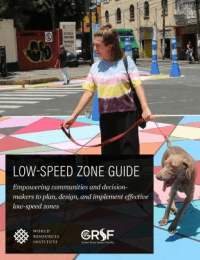
Every year approximately 1.35 million people lose their lives due to road traffic crashes. In many road crashes, speed plays a key role. As a result, managing speed has taken on great importance in cities around the world.
An effective method for reducing speed and improving road safety, especially in high-risk areas, has been to establish low-speed zones. This Low-Speed Zone Guide presents strategies for planning, designing, building, and evaluating low-speed zones. The guide intends to equip communities and decision-makers with the tools to implement low-speed zones that will suit their specific context.
Highlights:
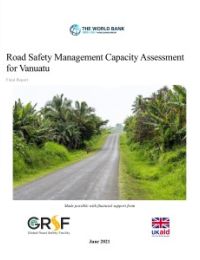
This Road Safety Management Capacity Assessment (RSMCA) seeks to gain a broad understanding of the Government of Vanuatu's road safety management capacity to support its plans to improve road safety outcomes throughout the country. The RSMCA follows the seven critical road safety institutional management functions (Bliss and Breen 2013) to identify key challenges and provide recommendations for improvement in road safety management, and similarly addresses the Safe System pillars for the interventions level. The seven institutional management functions include: results focus, coordination, legislation, finance and resource allocation, promotion and advocacy, monitoring and evaluation, and research and development of knowledge transfer.
The Safe System pillars include road safety management, safe roads and mobility, safe vehicles, safe road users, post-crash care, and safe speeds. The RSMCA’s alignment with both the road safety institutional management functions and the Safe System Approach in turn aims to help the Government of Vanuatu to prioritize targeted next steps to address road crash death and serious injury in the country.



